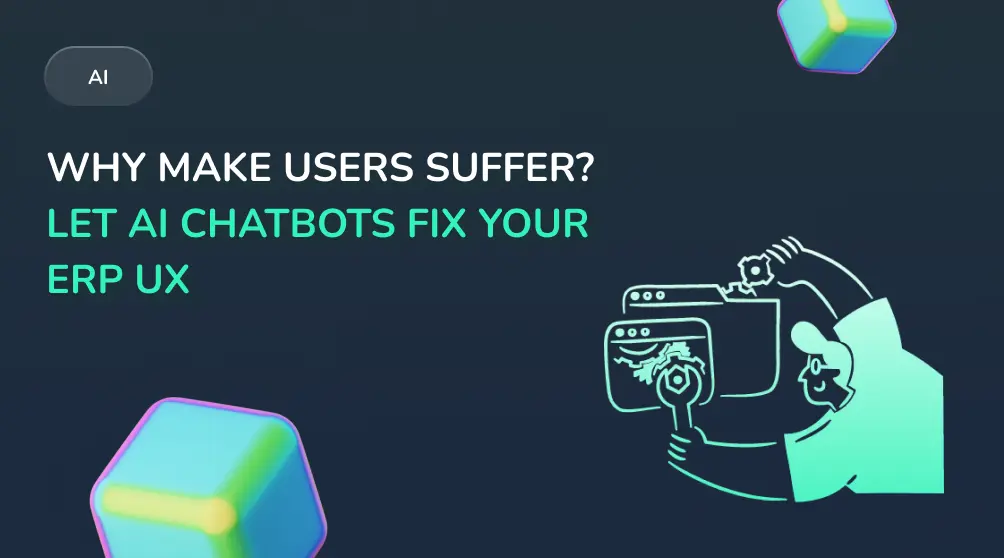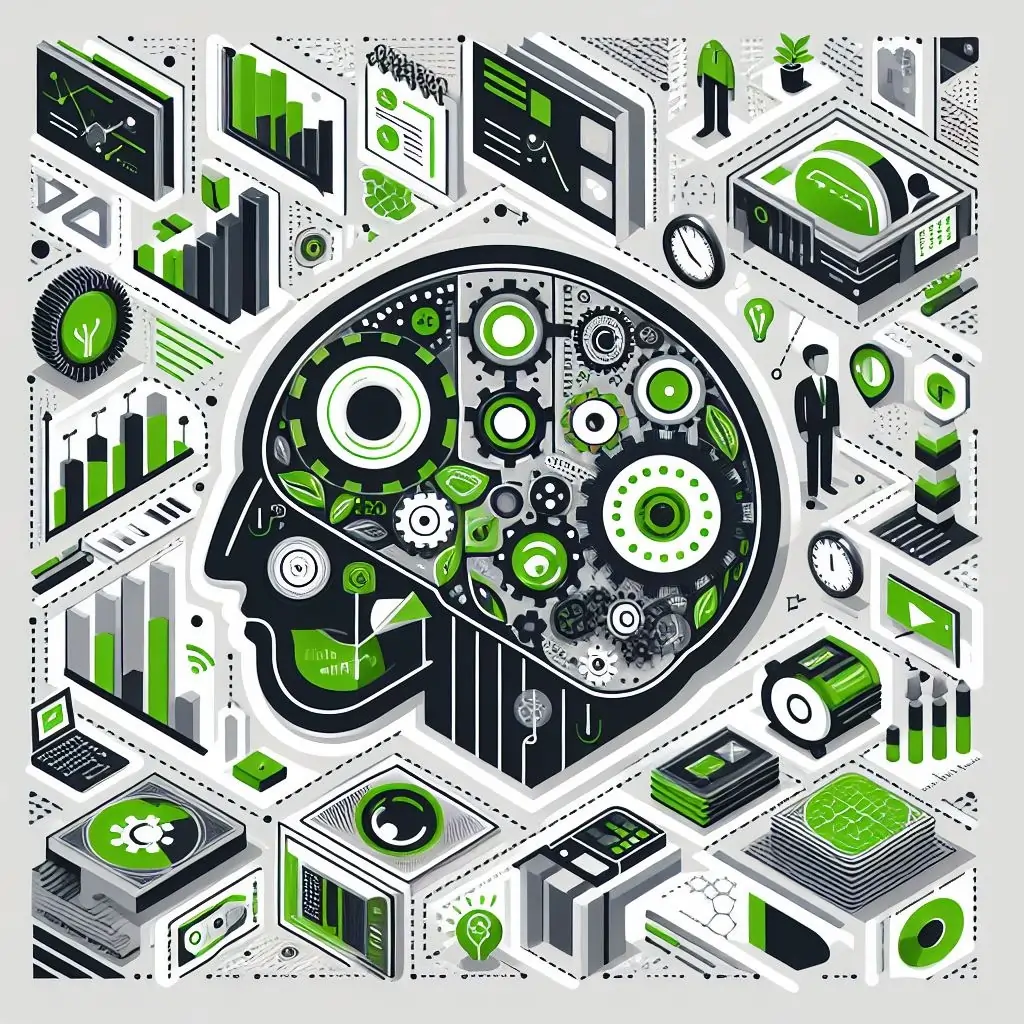
Have you ever spent hours locating a specific function within your ERP system? Or perhaps your employees frequently reach out to support with the same questions? While ERP solutions are designed to streamline operations, they often appear more tailored for technical users than ordinary staff. This complexity can hinder productivity and lead to increased training costs.
However, you can streamline your internal workflow without reinventing the EPR. All you need to do is launch a chatbot for your employees.
These “virtual friends” can process natural language and provide the needed info within seconds, reducing the burden on support teams. Today, we’ll explore how such chatbots can streamline your team’s workflow.
3 Most Common Challenges of ERP Users
Internal management systems are crucial for any business, even the smallest ones. However, the complexity of these services can become a major obstacle to their implementation. Despite best efforts, your staff may just get lost in all its features.
Let’s explore the key issues of such systems quickly and how ERP AI chatbots can help address them.
Complexity of Navigation
Most enterprise systems are complex with a myriad of features. While more modern software has multi-level user access, older ERP systems just gather everything in one place without adequate sorting.
Complex interfaces can hinder the adoption of the tool and the productivity of your business. For instance, a report by Panorama Consulting highlights that an intuitive, friendly ERP interface directly impacts the overall project success, emphasizing the importance of intuitively clear designs.
It’s often impossible or requires too much time to redo the whole system, so many businesses decide to launch internal conversational AI for enterprise. Other businesses launch AI tools for different branches, which can automate complex repetitive tasks, predict user needs, and provide real-time guidance.
Feature Overabundance
While the comprehensive functionality of ERP systems is great for big companies, it overwhelms users, especially those not specialized in certain areas. So, many employees may underutilize the system’s capabilities, diminishing the return on investment.
For instance, financial management modules might be intuitive for the accountants, but pose challenges for employees in marketing or procurement. HR departments might find supply chain modules confusing, causing them to miss out on useful features simply because they don’t understand how they work.
To mitigate these challenges, you can leverage role-based interfaces with AI-based improvements to display only a short list of relevant features. It helps them reduce the staff’s cognitive load.
High Demand for User Training
Resistance to change is a significant barrier in ERP adoption, accounting for 24% of challenges faced during its implementation.
Those companies that want to launch their EPR should train all their users. Yep, it may be resource-intensive, but it will save you a lot of money in the long run. The steep learning curve can lead to stress among new employees and may hinder the adoption and the client experience.
How AI Chatbots for Businesses Address Common EPR Challenges
Integrating AI-powered chatbots into Enterprise Resource Planning (ERP) systems can significantly enhance user experience by simplifying interactions, streamlining navigation, and automating routine tasks. The enterprise AI chatbot acts as an intermediary between users and complex ERP interfaces, facilitating quicker access to information and reducing the learning curve.
With them, users can interact with a complex system with natural language. Instead of spending eternity filtering inventory, employees can simply ask, “How many bottles of Pantene shampoo are left in our inventory?” The enterprise virtual assistant will answer this question within seconds.
AI chatbots can automate repetitive tasks or serve as on-demand training resources, guiding users through complex processes. Let’s dive into the specifics of enterprise chatbots!

Complex software can drive you crazy. But AI chatbots can simplify them for everybody and their moms
Streamlining Navigation
Instead of struggling with complicated menus, employees can just type:
- How do I generate an expense report?
- Where can I find stock level information?
The enterprise AI chatbot solution instantly provides the relevant information or directs the user to the appropriate sections. AI-driven assistants deliver step-by-step guidance tailored to each user.
Simplifying Interactions
AI solutions for enterprise serve as assistants, fostering system exploration. So, when your staff tries to process an order, the chatbot can walk them through the steps and even help fill in the required fields. A chatbot for enterprises can analyze user behavior to suggest relevant features to simplify the workflow.
Automating User Support
Integrating a chatbot for enterprises simplifies the execution of daily tasks, as users can execute commands by simply telling the bot what to do. Users can input commands into the ERP chatbot like “Add a new staff with the following details or “Show me the financial report for the last month,” and the bot will enter all the info automatically.
Enhancing Productivity and Reducing Stress
ERP systems are crucial for big companies. However, they are often too complicated for an average employee. A great AI chatbot provides users with immediate answers to their questions, minimizing human errors. Offering prompts helps users avoid common mistakes, such as missing data entries or overlooking critical steps in a workflow.
By alleviating the cognitive load, enterprise conversational AI platforms significantly reduce user stress. Employees can focus more on strategic and artistic tasks rather than dealing with the tech intricacies.

Lower anxiety levels of your employees with AI. Let them chat with the friendly tool that simplifies the user journey for them
4 Crucial ERP Design Elements
To build a bot that truly works, you need to thoughtfully combine several crucial design aspects into it:
- Contextual understanding
- Personalization
- Minimalist design
- Multimedia support
Master these 4 elements, and improve teams’ productivity with the new tool.
Contextual Understanding
Imagine a bot at work that understands your thoughts about the quarter report just like ChatGPT comprehends you during an improvised therapy session about your last relationship.
Your new chatbot should know how to process natural language. Otherwise, it will be just another “extra tool” that no one uses.

Personalization
Your chatbot should know who it’s talking to! A CFO and a salesperson need different insights. So it’s better to implement the AI tool that will also understand the differences between different roles.
Minimalist Design
Even chatbots are in their “clean girl era”. An uncluttered interface prevents overwhelming. In the long run, it speeds up all processes. So, we recommend that you keep everything simple.
Multimedia Examination
Including multimedia analysis in your chatbot can significantly enhance its capabilities. Imagine requesting an image of “a man sitting on a cow” or “a woman writing a receipt” from your library, and the tool will find it in the library.
While your content manager may spend hours searching the library, AI will do it within seconds.
What Algorithms Can You Use In Your AI for ERP?
Integrating an AI-powered chatbot can significantly enhance user interaction and operational efficiency. These assistants use Natural Language Processing (NLP) and Machine Learning (ML) algorithms to interpret and respond to user queries.
As we said before, one of the greatest benefits of chatbots for business is that they can automate repetitive chores such as report generation and order processing. Chatbots can also clarify fuzzy queries rather than providing generic error messages. For example, if a user asks, “Show me the report,” the bot can respond with, “Which one? Sales or Inventory?” This proactive approach reduces the potential for frustration.
6 Stages of Developing ERP and CRM Chatbot
We, at Corpsoft Solutions, stick to the agile-multistep approach. That’s how we can be sure that your future software fits the latest trends and regulations. The exact process varies from niche to niche. However, there are 6 stages of developing enterprise conversational AI platforms that fit any company:
- Defining objectives and use cases: Identify the chatbot’s main purpose and decide if it will be rule-based with some AI, or fully powered by AI.
- Choosing the appropriate AI platform: Select enterprise conversational AI platforms compatible with your current software. Your potential options range from pre-built solutions like Dialogflow to custom implementations using libraries like NLTK or spaCy.
- Designing conversational flows: Map out typical interactions, ensuring your bot helps your staff in ordinary situations.
- Integration and deployment: Seamlessly integrate the ERP AI chatbot, ensuring it can access and process relevant data.
- Employee Training and Deployment. The next stage is to teach your staff how to properly use the chatbot. We recommend that you develop comprehensive training materials, such as user manuals, tutorials, and FAQs. Establish a helpdesk or support channel to assist employees as they adapt to the new tool.
- Continuous Improvement and Testing. It’s a crucial stage, since it’s the only way to gather user feedback in real-life situations.
Given how complex development can get, it’s a good idea to partner with experts. They’ll help navigate the details and make sure the solution is tailored to you.
How AI-Powered ERP Transformed a B2B International Business: A Real-Life Example
Imagine ‘ACME,’ a firm that creates and sells industrial equipment. After they went global, their productivity dropped to 40%, even though they were doing everything right.
So, they decided to implement an AI chatbot into their e-commerce ERP system to reduce the workload and speed up responses to the worldwide clients.
To make sure that this AI ERP chat will fit them, they need to:
- Evaluate their needs: Identified that the chatbot should handle inquiries regarding product availability and order status, and provide basic product information.
- Determine future functions, such as product availability checks, order status updates, and product recommendations.
- Develop and launch the Chatbot: It’s the longest stage, where developers create a bot and integrate it into the system.
As a result, ACME will answer faster, which improves their reputation and positively affects their ROI.
Wrapping Up
Do your staff find internal tools difficult to work with? AI-based chatbots can simplify their workflow, offering perfectly tailored experiences that perfectly match each employee. But building enterprise chatbot consulting services takes time. So why not let experienced developers fasten this process?
At Corpsoft Solutions, we are experts in AI integrations and are glad to help you make your internal software more user-friendly. Are you ready to change and implement the power of machine learning? Contact our team today to make your business prosper tomorrow!
Subscribe to our blog


